Thick hair is a beautiful blessing, but finding the perfect short hairstyle that manages volume while showcasing texture can feel like searching for a needle in a haystack.
Enter the wavy pixie—a stunning fusion of edgy sophistication and natural movement that transforms thick locks into a work of art. If you’ve been contemplating a dramatic chop but worry about losing femininity or dealing with unmanageable bulk, wavy pixie hairstyles offer the perfect solution.
This comprehensive guide explores 27 gorgeous wavy pixie hairstyles specifically designed for thick hair, from tousled and textured to sleek and side-swept variations.
Whether you’re seeking low-maintenance elegance, bold statement styles, or professional looks that transition seamlessly from office to evening, you’ll discover cutting techniques, styling secrets, and visual inspiration that will make your next salon appointment utterly transformative.
Get ready to embrace the liberating world of short hair without sacrificing the gorgeous waves that make thick hair so enviable.
Contents
- 1 1. Classic Textured Wavy Pixie
- 2 2. Asymmetrical Wavy Pixie with Deep Side Part
- 3 3. Wavy Pixie with Undercut Design
- 4 4. Long Wavy Pixie (Pixie Bob)
- 5 5. Choppy Layered Wavy Pixie
- 6 6. Wavy Pixie with Tapered Nape
- 7 7. Curly-Wavy Pixie with Defined Ringlets
- 8 8. Wavy Pixie with Swept-Back Crown
- 9 9. Wavy Pixie with Micro Bangs
- 10 10. Wavy Pixie with Longer Front Sections
- 11 11. Disheveled Wavy Pixie
- 12 12. Wavy Pixie with Razored Edges
- 13 13. Wavy Pixie with Shaved Sides
- 14 14. Wavy Pixie with Highlighted Texture
- 15 15. Wavy Pixie with Textured Fringe
- 16 16. Voluminous Wavy Pixie with Root Lift
- 17 17. Wavy Pixie with Disconnected Layers
- 18 18. Soft Wavy Pixie with Rounded Silhouette
- 19 19. Wavy Pixie with Peek-a-Boo Color
- 20 20. Wavy Pixie with Baby Bangs
- 21 21. Tousled Wavy Pixie with Sea Salt Texture
- 22 22. Wavy Pixie with Graduated Neckline
- 23 23. Wavy Pixie with Finger Waves
- 24 24. Wavy Pixie with Textured Crown
- 25 25. Edgy Wavy Pixie with Multiple Lengths
- 26 26. Wavy Pixie with Side-Swept Volume
- 27 27. Natural Wavy Pixie with Air-Dried Texture
- 28 Styling Tips for Wavy Pixie Cuts on Thick Hair
- 29 Maintenance Schedule for Wavy Pixie Cuts
- 30 Face Shape Considerations
- 31 Color Ideas for Wavy Pixie Cuts
- 32 Transitioning to a Wavy Pixie
- 33 Common Mistakes to Avoid
- 34 Styling Wavy Pixies for Different Occasions
- 35 Seasonal Adaptations
- 36 Cost Considerations
- 37 Confidence and Lifestyle Impact
- 38 Conclusion
1. Classic Textured Wavy Pixie
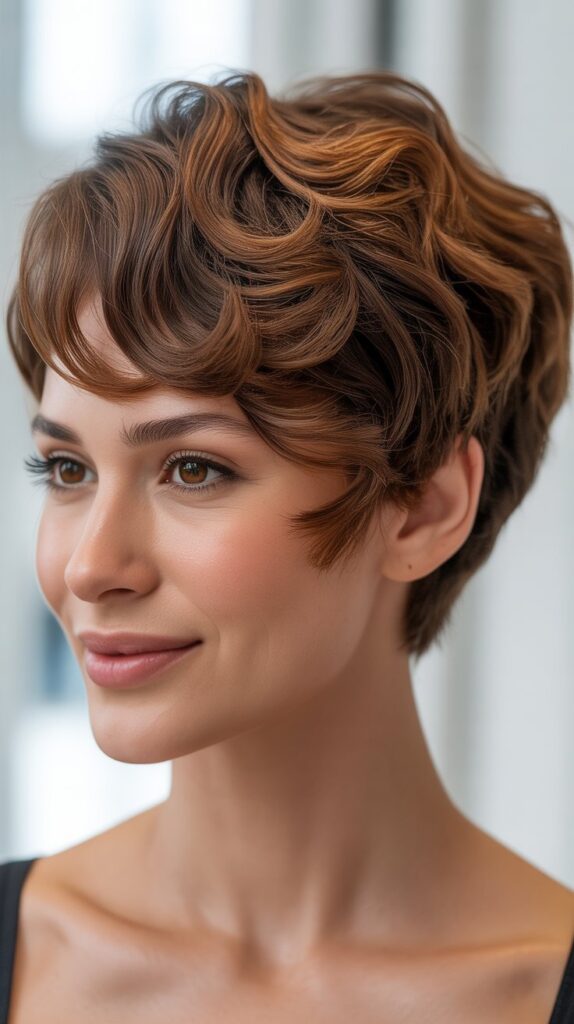
The classic textured wavy pixie serves as the foundation for all variations in this style family, combining timeless elegance with modern styling techniques that celebrate thick hair’s natural body. This versatile cut features slightly longer lengths on top with shorter, tapered sides that create beautiful dimension and movement.
- The classic textured wavy pixie works exceptionally well for thick hair because it removes bulk from the sides while maintaining enough length on top to showcase natural wave patterns.
- Stylists typically cut the top section between 2-4 inches, using point-cutting and texturizing techniques to prevent the triangle effect that thick hair can create.
- The back and sides are gradually tapered, creating a clean neckline that prevents heaviness while the textured top adds softness and femininity.
- This foundational style allows for multiple styling options, from tousled and messy to more polished and refined, depending on your daily needs.
- Product application is key—lightweight mousse or sea salt spray enhances waves without weighing down thick hair or creating greasiness.
- The classic version requires minimal daily maintenance, typically just 5-10 minutes of scrunching and air-drying or quick diffusing.
- This cut grows out gracefully, maintaining its shape for 6-8 weeks before requiring professional trimming.
2. Asymmetrical Wavy Pixie with Deep Side Part
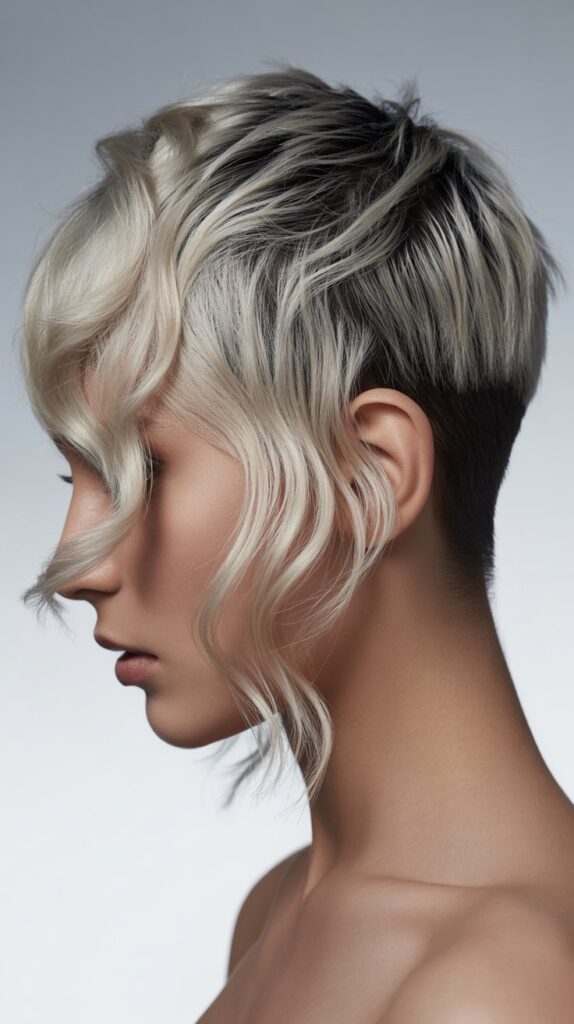
The asymmetrical wavy pixie with deep side part introduces dramatic visual interest by creating intentional imbalance that flatters face shapes while managing thick hair’s volume strategically. This bold variation features significantly longer hair swept to one side with a contrasting shorter opposite side.
- The deep side part creates an immediate focal point, drawing attention to your best features while the asymmetry adds contemporary edge to the traditional pixie.
- One side is typically cut quite short (often clipped or buzzed), while the opposite side maintains 3-5 inches of length that cascades across the forehead and cheekbone.
- This strategic distribution of weight prevents thick hair from looking boxy or overwhelming, instead channeling volume into a deliberate design element.
- The longer side can be styled with enhanced waves using a small-barrel curling iron or by braiding damp hair overnight for heat-free texture.
- Face-framing layers within the longer section prevent a flat appearance and create movement that softens angular features.
- The dramatic contrast between sides makes this style particularly photogenic and memorable for those seeking statement-making hair.
- Maintenance involves more frequent trims every 4-6 weeks to maintain the sharp contrast between the short and long sections.
3. Wavy Pixie with Undercut Design
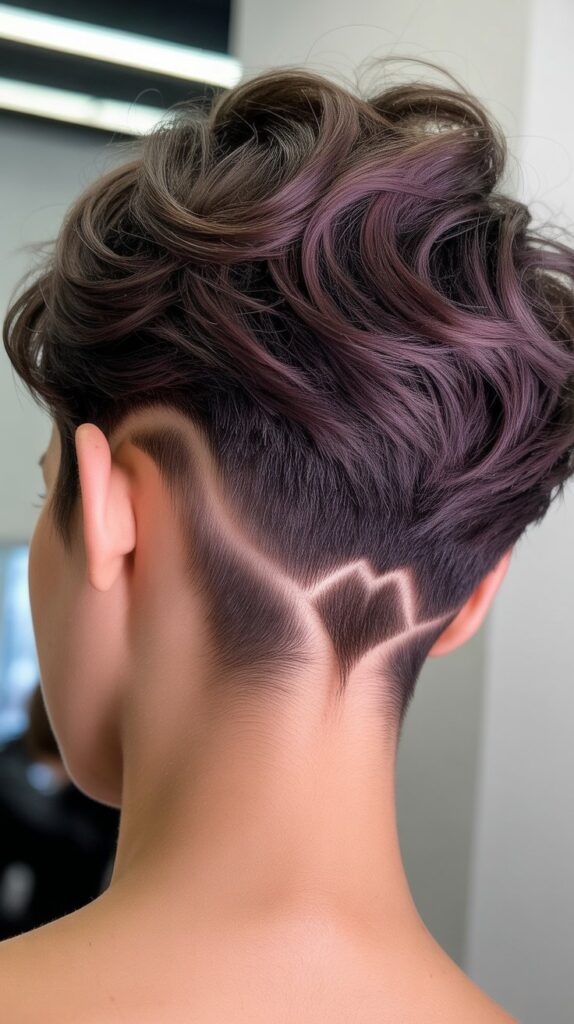
The wavy pixie with undercut design elevates the standard pixie by incorporating shaved patterns or faded sections that provide both functional bulk removal and artistic expression. This combination creates a stunning contrast between the soft waves on top and the crisp, clean lines underneath.
- Undercuts serve a practical purpose for thick hair by removing significant weight and volume from the densest areas, typically at the nape and around the ears.
- The shaved or closely cropped sections can feature geometric patterns, lines, or faded gradients that add personalized artistic elements to your hairstyle.
- The top section maintains enough length (usually 3-4 inches) to create beautiful wavy texture that can be styled forward, to the side, or swept back depending on the occasion.
- This style offers incredible versatility—wear your hair down to showcase the waves, or pin it up to reveal the intricate undercut design for a completely different look.
- Cooling and comfort factors make this an excellent choice for those living in warm climates or who find thick hair uncomfortably hot.
- The undercut requires maintenance every 2-4 weeks to keep patterns sharp and prevent the shaved section from becoming fuzzy or losing definition.
- Temporary or permanent hair color on the undercut design can add another dimension of creativity to this already striking style.
4. Long Wavy Pixie (Pixie Bob)
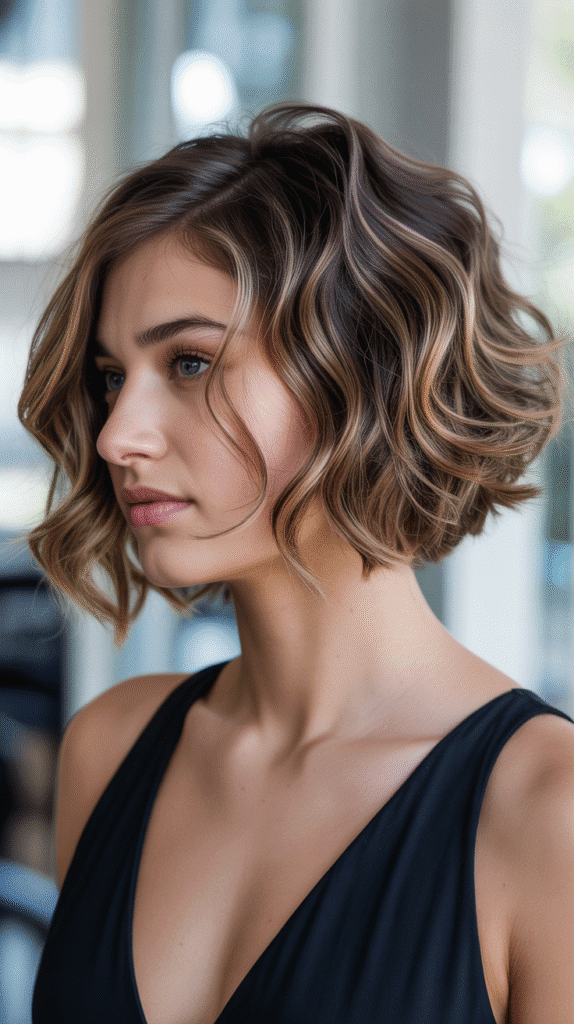
The long wavy pixie, often called a pixie bob, bridges the gap between traditional pixie cuts and bob hairstyles, offering more length while maintaining the manageability and edge associated with short hair. This extended variation is particularly flattering for those with thick hair who want dramatic change without committing to ultra-short lengths.
- Length typically ranges from 4-6 inches throughout, with the longest pieces reaching just below the ears or grazing the jawline.
- The additional length provides more styling versatility, allowing for tucking behind ears, creating small braids, or using mini clips and accessories.
- Thick hair shines in this cut because the extra length showcases natural wave patterns beautifully while maintaining enough body to prevent limpness.
- Layering throughout removes bulk strategically, creating movement and preventing the mushroom effect that can plague thick-haired individuals with one-length bobs.
- This transitional length is perfect for those growing out a shorter pixie or testing the waters before committing to a more dramatic crop.
- Styling time increases slightly compared to shorter pixies (10-15 minutes) but remains far more manageable than medium or long hairstyles.
- The longer length grows out more forgivingly, allowing 8-10 weeks between trims while still maintaining an intentional, polished appearance.
5. Choppy Layered Wavy Pixie

The choppy layered wavy pixie embraces intentional irregularity, using disconnected layers and varied lengths to create edgy texture that manages thick hair’s volume while adding contemporary style. This rebellious variation rejects uniformity in favor of deliberately jagged, piece-y sections.
- Choppy cutting techniques involve using razors, shears, or point-cutting methods to create uneven, textured ends rather than blunt, uniform lines.
- Multiple distinct layers throughout the cut prevent thick hair from creating a heavy, solid mass, instead breaking it into moveable, dynamic sections.
- The deliberately messy aesthetic means imperfection is built into the design—slightly asymmetrical sections and varied lengths are features, not flaws.
- This style particularly suits naturally wavy or curly thick hair, as the texture enhances the choppy effect without requiring excessive heat styling.
- Product selection focuses on matte, piecey finishes using clay, paste, or texturizing sprays rather than shine-enhancing serums or gels.
- The choppy layered pixie embodies low-maintenance cool, often looking better slightly tousled and lived-in rather than freshly styled.
- Growing out this cut transitions naturally into shaggy, textured styles without awkward in-between stages that require constant styling intervention.
6. Wavy Pixie with Tapered Nape

The wavy pixie with tapered nape focuses attention on the back of the head, creating a sleek, gradually shortened section at the neck that provides clean structure while the top maintains gorgeous wavy volume. This refined approach offers sophistication and polish that works beautifully in professional environments.
- The tapered nape involves gradually decreasing hair length from the occipital bone down to the hairline, creating a soft, feminine finish at the neck.
- This technique dramatically reduces bulk in an area where thick hair often creates unwanted width, resulting in a more elongated, graceful neck appearance.
- The contrast between the structured, precise nape and the soft, wavy crown creates beautiful visual interest from all angles.
- Maintenance of the tapered section requires professional attention every 4-6 weeks to maintain the clean, graduated effect and prevent a grown-out, unkempt appearance.
- The wavy top can be styled in various directions—forward for a softer look, swept back for more drama, or side-parted for asymmetry—while the nape remains consistently polished.
- This combination works exceptionally well for heart-shaped and oval faces, as the tapered nape emphasizes the facial structure without adding width.
- Product application should focus on the crown and top sections, keeping the tapered nape free of heavy products that might weigh down the precise shape.
7. Curly-Wavy Pixie with Defined Ringlets
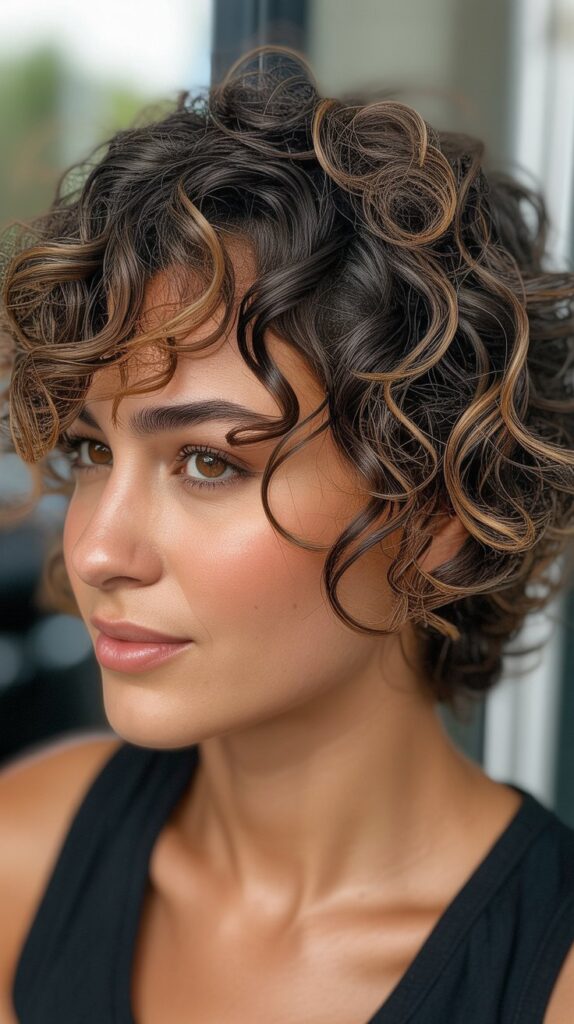
The curly-wavy pixie with defined ringlets celebrates natural curl patterns in thick hair, transforming tighter textures into a sculptural, dimensional style that showcases individual curl formation. This variation requires embracing rather than fighting your hair’s natural tendencies.
- Curl-specific cutting techniques like DevaCut or Rezo Cut are essential for this style, involving cutting dry, styled curls to ensure each ringlet falls perfectly.
- Thick, curly hair contains tremendous volume, so strategic layering and undercutting remove weight while allowing curls to spring freely without creating pyramid shapes.
- The shorter length prevents curls from drooping or losing definition due to their own weight, maintaining bouncy, well-formed ringlets throughout the day.
- Hydration-focused product routines using leave-in conditioners, curl creams, and gels help define individual curls while preventing frizz and maintaining shine.
- Diffusing with low heat or air-drying maintains curl integrity better than direct heat styling, which can disrupt natural curl patterns in thick hair.
- This style celebrates texture diversity—each section may have slightly different curl patterns, creating organic, beautiful variation throughout the cut.
- Refresh routines between wash days involve water-based sprays and curl reactivating products rather than complete restyling, preserving curl definition while maintaining volume.
8. Wavy Pixie with Swept-Back Crown
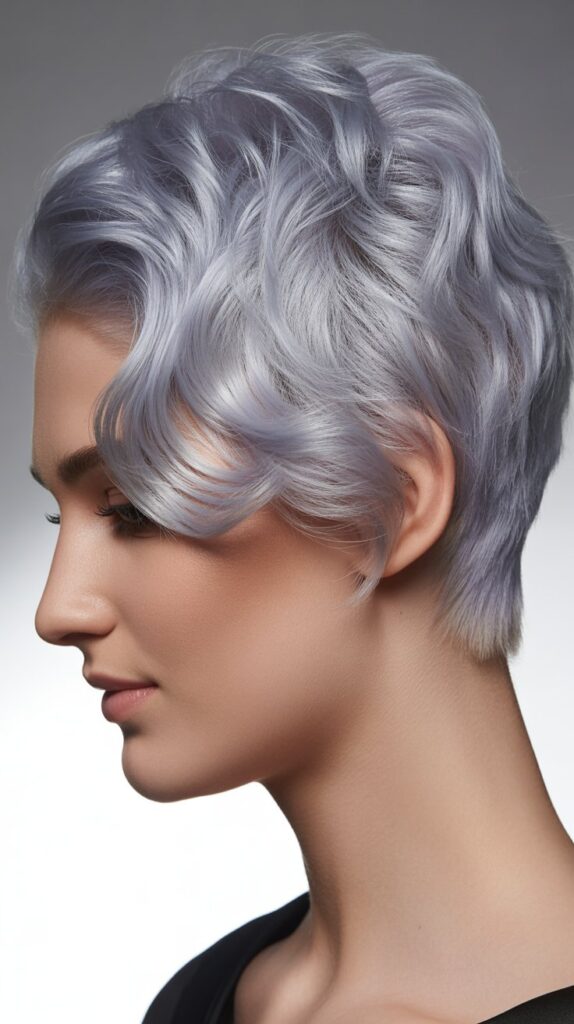
The wavy pixie with swept-back crown creates sophisticated volume at the top of the head while maintaining shorter, cleaner sides, offering a style that commands attention and works beautifully for formal occasions. This dramatic variation adds height and elegance to the traditional pixie silhouette.
- The crown section is cut longer (typically 4-5 inches) and styled backward and upward, creating impressive lift that elongates the face and adds stature.
- Thick hair is particularly suited to this style because it provides the natural volume and body needed to maintain the swept-back shape without excessive teasing or product.
- Styling involves applying volumizing mousse or root-lifting spray to damp hair, then blow-drying with a round brush while directing hair backward from the hairline.
- The sides and back remain shorter and closer to the head, creating beautiful contrast with the voluminous crown and preventing an overwhelming silhouette.
- This style works exceptionally well for rectangular and square face shapes, as the vertical emphasis and height balance angular jawlines.
- Finishing with flexible-hold hairspray maintains the swept-back shape throughout the day while allowing natural movement that prevents stiffness.
- The dramatic styling makes this variation perfect for special events, professional presentations, or any situation where you want to make a powerful first impression.
9. Wavy Pixie with Micro Bangs
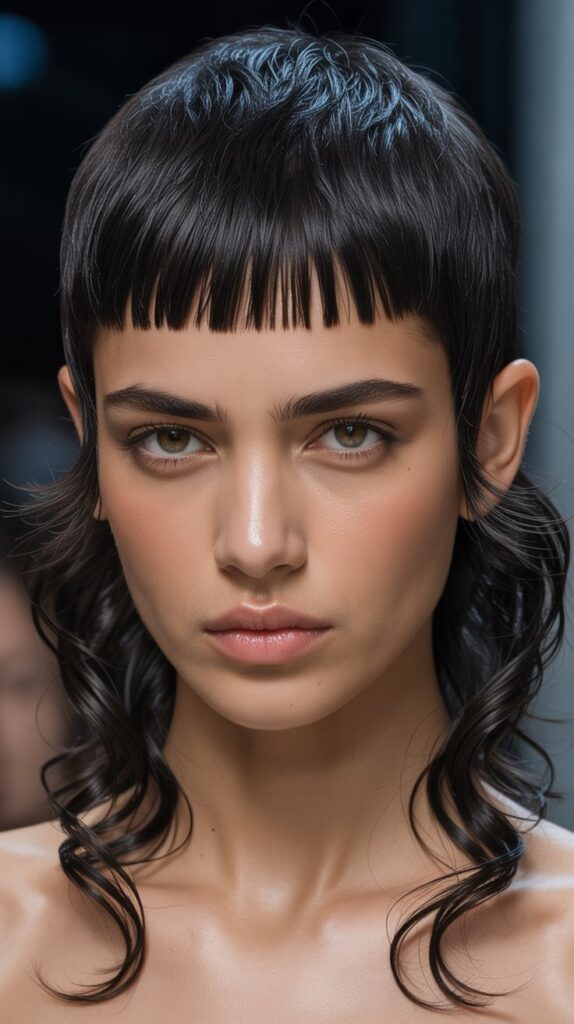
The wavy pixie with micro bangs adds unexpected edge by incorporating ultra-short, blunt fringe that contrasts beautifully with the textured, wavy sections throughout the rest of the cut. This bold combination creates a striking, fashion-forward look that stands out in any crowd.
- Micro bangs are cut significantly shorter than traditional fringe, typically ending 1-2 inches above the eyebrows, creating deliberate visual impact.
- The blunt, straight line of micro bangs provides geometric contrast to the soft, irregular waves in the remaining hair, balancing edgy precision with organic texture.
- Thick hair handles micro bangs well because sufficient density prevents sparse, wispy fringe while the bulk removal from bangs reduces overall weight.
- This style requires commitment and confidence—micro bangs are immediately noticeable and don’t blend subtly into the overall hairstyle.
- Maintenance involves frequent bang trims every 2-3 weeks to maintain the precise length, though the remaining pixie can extend longer between cuts.
- Styling the wavy sections while keeping bangs straight creates intentional texture contrast that enhances both elements of the cut.
- This combination particularly flatters oval and heart-shaped faces, while those with longer face shapes may find micro bangs create appealing horizontal balance.
10. Wavy Pixie with Longer Front Sections

The wavy pixie with longer front sections maintains extended lengths around the face while keeping the back and sides short, creating a flattering frame that softens features while preserving the pixie’s characteristic edge. This variation offers feminine balance to the dramatic short cut.
- Front sections typically range from 3-6 inches, long enough to tuck behind ears, sweep across the forehead, or style forward to frame the cheekbones.
- The longer front pieces can be styled with enhanced waves using small curling tools, or left to air-dry for natural, effortless texture.
- This strategic length distribution removes bulk from areas where thick hair tends to add unwanted width (back and sides) while maintaining softness where it flatters most.
- The longer front sections offer styling versatility unavailable in uniform-length pixies—create side parts, center parts, or swept-back styles depending on your mood.
- Face-framing layers within the longer sections prevent heaviness and create movement that draws attention to eyes and cheekbones.
- This cut provides a security blanket for pixie newcomers who worry about going too short—the longer front maintains some familiar length while the short back delivers dramatic change.
- Growing out is relatively seamless, as the longer front sections blend naturally into bob territory while the back catches up over time.
11. Disheveled Wavy Pixie
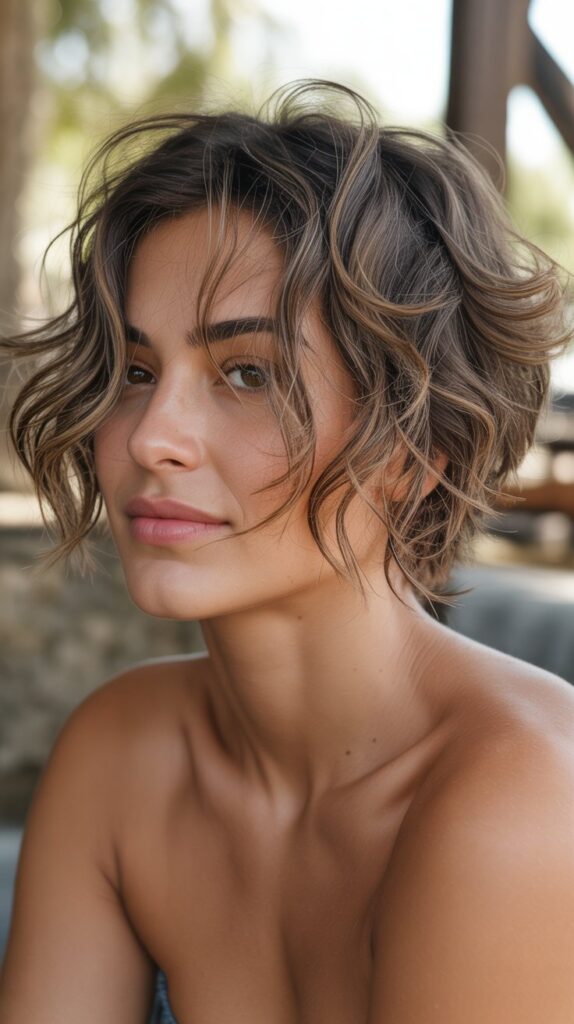
The disheveled wavy pixie embraces intentional messiness, creating an effortlessly cool, just-rolled-out-of-bed aesthetic that manages thick hair while appearing completely unstudied. This relaxed variation proves that perfection lies in imperfection.
- The deliberately tousled appearance is actually carefully crafted through specific cutting techniques that create varied lengths and remove bulk strategically.
- Thick hair’s natural volume and body make it ideal for disheveled styles—the hair maintains shape and movement without appearing limp or lifeless.
- Styling involves minimal intervention: apply texturizing spray or salt spray to damp hair, scrunch randomly, and allow to air-dry or diffuse briefly for enhanced waves.
- The beauty of this style lies in its forgiveness—there’s no single “correct” way it should look, making bad hair days virtually impossible.
- Product selection focuses on matte, piecey textures using clays, pastes, or dry texturizing sprays rather than shine-enhancing products that create “done” appearances.
- This low-maintenance option suits busy lifestyles, requiring only 5 minutes of morning styling while maintaining stylish edge throughout the day.
- The disheveled aesthetic grows out gracefully, with slightly longer lengths simply adding to the intentionally undone, carefree vibe.
12. Wavy Pixie with Razored Edges

The wavy pixie with razored edges incorporates specialized cutting techniques using straight razors to create ultra-thin, feathered ends that reduce bulk dramatically while adding modern, edgy texture. This technique-driven variation delivers maximum movement and dimension.
- Razor cutting slices through hair at angles rather than bluntly cutting across, creating thinner, softer ends that move more freely and reduce the appearance of density.
- For thick hair, razoring is particularly beneficial because it removes internal weight without sacrificing length, preventing heavy, solid shapes.
- The feathered, irregular ends created by razor cutting enhance natural wave patterns, as lighter ends move and curl more easily than blunt-cut sections.
- This technique creates beautiful dimension and depth as light hits the varied lengths and angles throughout the cut, making color dimension more visible.
- Razored pixies require skilled stylists experienced in the technique, as improper razor cutting can create damage or unwanted frizz in some hair types.
- Styling products should emphasize the piecey, separated texture that razoring creates—avoid heavy, smoothing products that eliminate the intentional texture.
- Maintenance visits every 6-8 weeks keep the razored ends fresh and prevent the fine tips from becoming damaged or split over time.
13. Wavy Pixie with Shaved Sides

The wavy pixie with shaved sides creates dramatic contrast between completely removed hair at the temples and ears and the voluminous, wavy hair maintained on top and crown. This bold variation offers maximum coolness and practicality for thick hair management.
- The shaved sections typically use clippers with guards ranging from #1-#3, creating closely cropped sides that may reveal skin or maintain minimal length.
- This extreme bulk removal is liberating for thick-haired individuals, eliminating significant weight and heat while creating striking visual impact.
- The preserved top section maintains 3-5 inches of length, showcasing beautiful wavy texture that contrasts gorgeously with the clean-shaven sides.
- Styling focuses entirely on the top section—applying products and creating texture where hair exists while the shaved sides require no maintenance.
- This style offers incredible versatility: wear hair styled forward for softness, swept back for drama, or to one side for asymmetry, always revealing the shaved sections.
- The shaved sides require frequent maintenance every 2-3 weeks to prevent stubble from growing out and losing the clean, intentional appearance.
- This variation suits confident individuals comfortable with bold, attention-grabbing styles that clearly communicate personality and style preferences.
14. Wavy Pixie with Highlighted Texture

The wavy pixie with highlighted texture uses strategic color placement to enhance dimension and movement, making waves more visible and creating depth that flatters the cut’s shape. This color-technique combination elevates the wavy pixie from great to extraordinary.
- Highlighting techniques like balayage, babylights, or foiling add lighter tones that catch light differently than base color, making individual waves more visible and defined.
- Thick hair benefits tremendously from highlighting because color breaks up solid, heavy appearance and creates the illusion of more movement and airiness.
- Strategic placement of highlights at the crown and face-framing sections draws attention to the most flattering areas while adding brightness near the complexion.
- Natural-looking color gradients that are 2-4 shades lighter than base color create subtle dimension, while more dramatic contrasts make bolder statements.
- Combining wavy texture with highlights creates beautiful interplay—light catches the high points of waves, creating shimmer and depth unavailable in flat styles.
- Color maintenance involves toning appointments every 6-8 weeks to prevent brassiness and refresh vibrancy, with full highlighting refreshes every 3-4 months.
- Using color-safe, sulfate-free products preserves highlight integrity and prevents premature fading, maintaining the dimensional effect longer between appointments.
15. Wavy Pixie with Textured Fringe
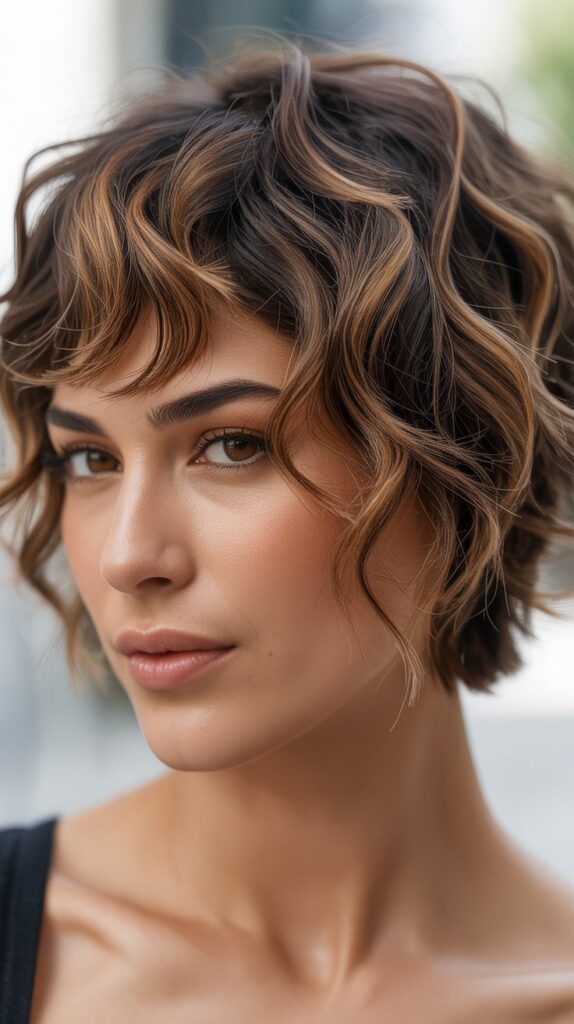
The wavy pixie with textured fringe incorporates irregular, piece-y bangs that blend seamlessly with the overall wavy texture, creating cohesive style from hairline to nape. This variation adds softness and femininity while maintaining the pixie’s characteristic edge.
- Textured fringe differs from blunt bangs through point-cutting, slicing, or razoring techniques that create uneven, separated pieces rather than a solid line.
- The irregular, piece-y nature of textured fringe complements thick hair’s natural volume, preventing bangs from appearing too heavy or overwhelming facial features.
- Length typically ranges from eyebrow-grazing to eye-level, with varied lengths throughout creating movement and preventing a single, flat plane across the forehead.
- Styling textured fringe involves minimal effort—apply lightweight product, sweep fingers through to separate pieces, and allow natural wave patterns to emerge.
- This fringe style grows out far more gracefully than blunt bangs, with longer pieces blending into side sections without creating obvious demarcation lines.
- The textured fringe frames the face beautifully while maintaining the edgy, contemporary feel essential to pixie cuts, avoiding overly sweet or traditional appearances.
- Maintenance involves bang trims every 3-4 weeks, though the textured, irregular nature means slightly longer fringe doesn’t immediately look unkempt or overgrown.
16. Voluminous Wavy Pixie with Root Lift
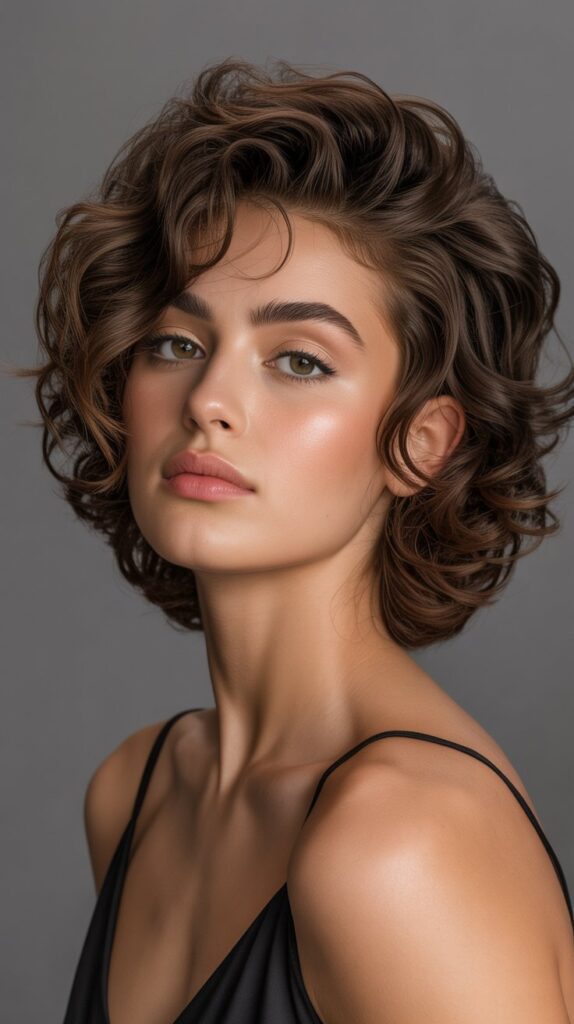
The voluminous wavy pixie with root lift maximizes thick hair’s natural body through strategic cutting and styling techniques that create impressive height and fullness at the crown. This glamorous variation delivers red-carpet-worthy impact for special occasions or everyday confidence.
- Root lifting techniques include volumizing product application, strategic blow-drying with round brushes, and sometimes subtle backcombing at the crown for maximum height.
- Thick hair provides the perfect foundation for voluminous styles because natural density creates substantial body without requiring excessive teasing or damaging techniques.
- The cut itself incorporates layering that removes weight from ends while maintaining density at roots, allowing hair to stand away from the scalp rather than lying flat.
- Styling involves focusing effort at the crown and top sections, blow-drying with a round brush while directing hair upward and backward for lift.
- This dramatic volume balances beautifully with shorter, sleeker sides and back, preventing an overwhelming or disproportionate silhouette.
- Finishing products include flexible-hold hairsprays that maintain lift throughout the day while allowing natural movement that prevents stiff, helmet-like appearances.
- The voluminous styling makes this variation perfect for formal events, professional presentations, or anytime you want to command attention and project confidence.
17. Wavy Pixie with Disconnected Layers
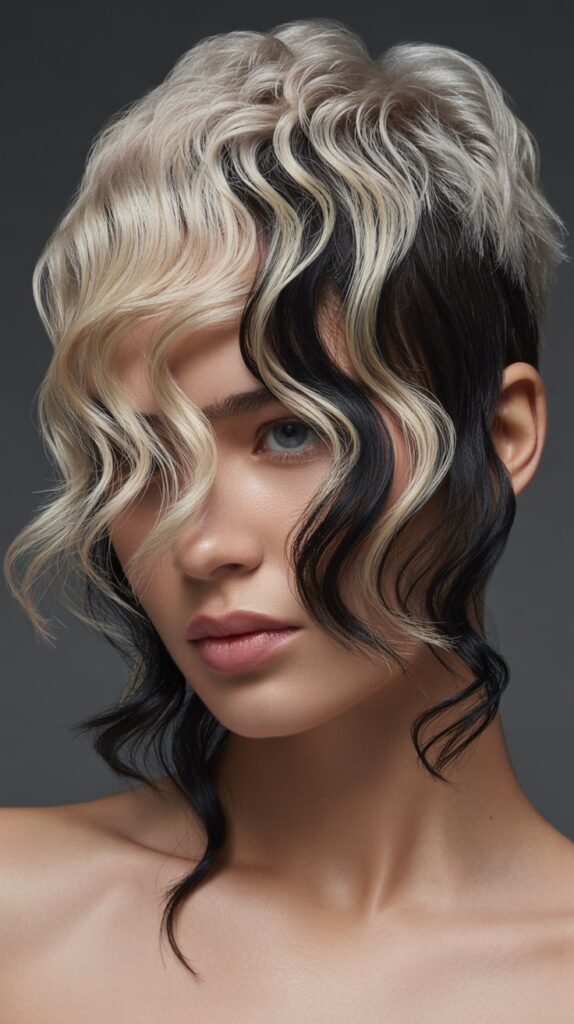
The wavy pixie with disconnected layers creates intentional separation between hair sections, resulting in a modern, architectural style that manages thick hair’s bulk through strategic weight distribution. This avant-garde variation delivers contemporary edge for fashion-forward individuals.
- Disconnected layering means visible gaps between layer lengths rather than smooth, blended transitions—creating distinct sections that move independently.
- This technique dramatically reduces bulk in thick hair by removing entire sections of intermediate lengths, leaving clearly defined longer and shorter pieces.
- The architectural quality of disconnected layers creates geometric interest and structure that photographs beautifully and makes strong visual statements.
- Styling emphasizes the intentional separation between sections using texturizing products that enhance definition rather than smoothing products that would blend layers.
- The distinct layers create beautiful movement as different sections swing and shift independently, showcasing thick hair’s natural body without overwhelming heaviness.
- This cutting-edge style requires skilled stylists comfortable with advanced techniques and confident clients who embrace unconventional, attention-grabbing aesthetics.
- Maintenance every 6-8 weeks preserves the distinct separation between layers and prevents intermediate lengths from growing in and disrupting the disconnected effect.
18. Soft Wavy Pixie with Rounded Silhouette
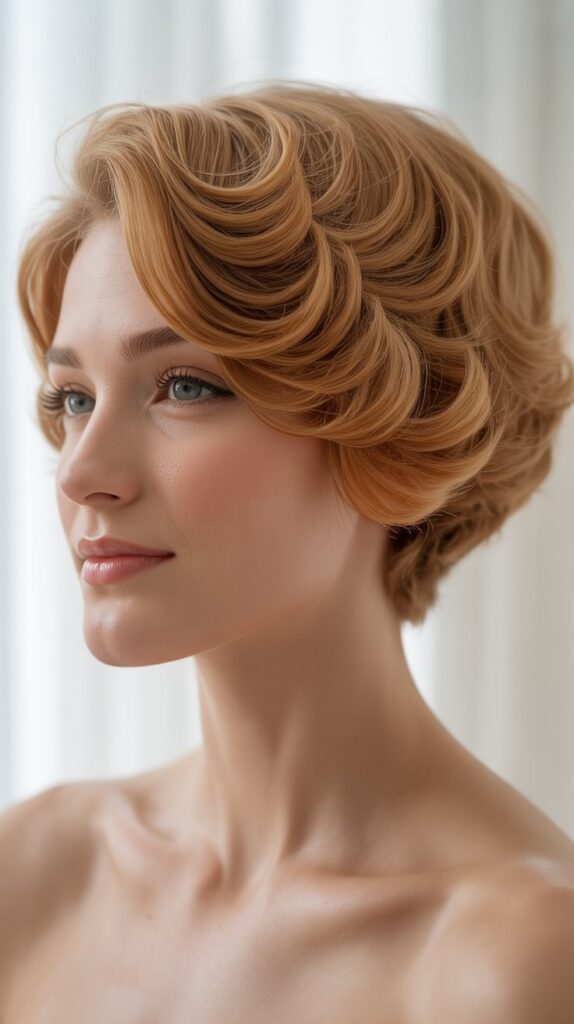
The soft wavy pixie with rounded silhouette prioritizes gentle, feminine shaping that creates a circular profile from all angles, offering a romantic alternative to edgier pixie variations. This approachable style softens features while managing thick hair beautifully.
- The rounded shape is achieved through graduated layering that creates a dome-like silhouette, with the longest hair at the crown gradually shortening toward the perimeter.
- This classic shape flatters virtually all face types by adding width where needed and removing it where beneficial, creating balanced proportions.
- Thick hair excels in rounded cuts because natural density maintains the full, rounded shape without requiring excessive styling or artificial volume creation.
- The soft, wavy texture enhances the rounded silhouette’s femininity, creating gentle movement and organic beauty rather than harsh, geometric lines.
- Styling involves encouraging hair to follow its natural wave pattern while directing it into the rounded shape using fingers, diffusing, or gentle blow-drying.
- This traditional approach to pixie cutting has endured for decades because it provides timeless elegance that transcends temporary trends and fads.
- The soft, approachable aesthetic makes this variation perfect for conservative professional environments or for those who want short hair without dramatic, edgy statements.
19. Wavy Pixie with Peek-a-Boo Color

The wavy pixie with peek-a-boo color incorporates hidden color panels beneath the top layers, creating surprise and dimension that reveals itself with movement and styling changes. This playful variation adds personality through strategic color placement.
- Peek-a-boo coloring involves applying vibrant, contrasting colors to underlayers—particularly at the nape, sides, or beneath the crown—that remain hidden when hair lies naturally.
- The wavy texture creates perfect opportunities for color to peek through, as waves shift and separate throughout the day, revealing flashes of the hidden color.
- Thick hair is ideal for this technique because sufficient density ensures the top layers adequately cover the colored sections when desired discretion is needed.
- Color choices range from subtle (darker tones for depth) to bold (vivid fashion colors like purple, blue, or pink for maximum impact).
- Styling versatility means you can display or hide the color depending on the situation—wear hair down and forward to conceal, swept back or up to reveal.
- This technique satisfies the desire for creative expression while maintaining professional versatility, as the color can be completely hidden when necessary.
- Color maintenance depends on the chosen shades—permanent colors require touch-ups every 6-8 weeks, while semi-permanent fashion colors need refreshing every 3-4 weeks.
20. Wavy Pixie with Baby Bangs
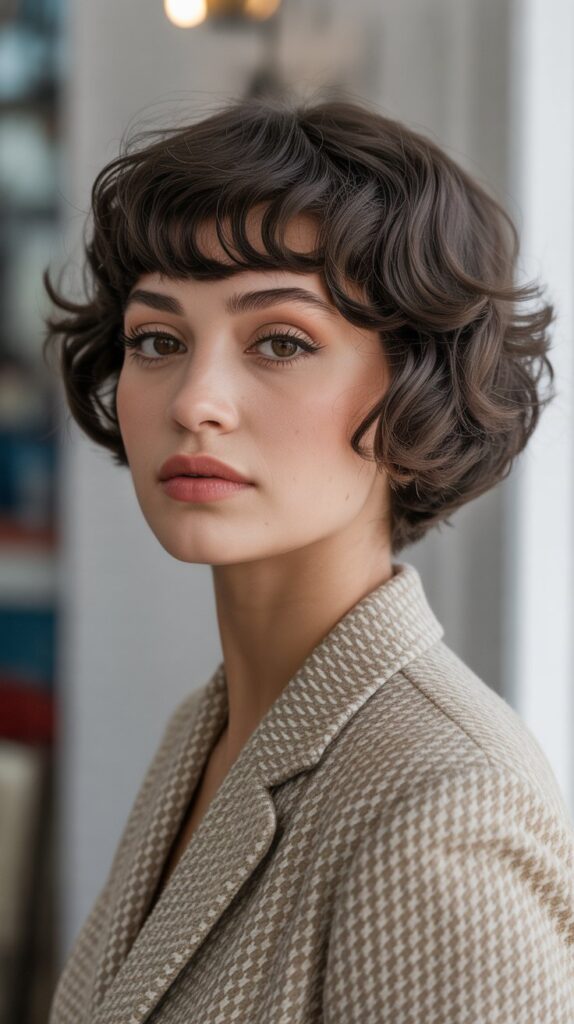
The wavy pixie with baby bangs combines ultra-short, delicate fringe with the textured body of a wavy pixie, creating a striking juxtaposition between the precise, straight bangs and organic, tousled remaining hair.
This retro-inspired variation delivers vintage charm with contemporary edge.
- Baby bangs are cut extremely short, typically ending mid-forehead or higher, creating a deliberately childlike, innocent appearance that contrasts with the sophisticated pixie cut.
- The wispy, delicate nature of baby bangs requires less density than standard fringe, making them achievable even in thick hair through strategic thinning and texturizing.
- This nostalgic fringe style evokes 1960s mod fashion and 1990s alternative aesthetics, appealing to those drawn to vintage-inspired or subcultural style influences.
- Styling keeps the baby bangs straight and precise while enhancing waves throughout the remaining hair, maintaining clear distinction between the two elements.
- The high-contrast combination creates immediate visual interest and memorable appearance, ensuring you won’t blend into crowds or be easily forgotten.
- Thick hair behind the baby bangs provides beautiful volume and body that prevents the overall style from appearing too delicate or wispy.
- Maintenance requires frequent bang trims every 2-3 weeks to preserve the ultra-short length, as even slight growth significantly impacts the baby bang effect.
21. Tousled Wavy Pixie with Sea Salt Texture

The tousled wavy pixie with sea salt texture embraces beachy, windswept aesthetics that celebrate natural movement and effortless style. This vacation-ready variation manages thick hair while delivering laid-back California cool.
- Sea salt spray products contain salt, minerals, and texturizing agents that enhance natural waves, create matte finish, and add grit that makes hair appear thicker and more textured.
- Application to damp hair followed by scrunching creates the foundation for beachy waves, while air-drying or diffusing on low heat allows natural texture to emerge.
- Thick hair responds beautifully to sea salt texture because the natural volume prevents limpness while the salt enhances wave definition without weighing hair down.
- The tousled appearance suggests carefree, adventurous personality—perfect for creative professionals, artists, or anyone who values relaxed, approachable aesthetics.
- Minimal styling time (5-10 minutes) makes this variation ideal for busy mornings, travel situations, or low-maintenance hair routines.
- The matte, slightly rough texture created by sea salt products provides excellent hold and prevents hair from falling flat throughout the day.
- This style transitions beautifully from day to night, looking appropriate at casual brunches, beach outings, office environments, and evening social gatherings.
22. Wavy Pixie with Graduated Neckline

The wavy pixie with graduated neckline features a precisely tapered back that creates clean, sophisticated shaping at the neck while maintaining wavy texture and volume on top. This refined variation balances professionalism with contemporary style.
- Graduated necklines involve carefully cutting the back section to create a smooth, diagonal line from longer crown hair to shorter nape, resulting in a precise, tailored appearance.
- This technique significantly reduces bulk at the nape—often the thickest area in thick hair—while creating elegant neck elongation and graceful lines.
- The clean structure of the graduated back provides beautiful contrast to the soft, organic waves on top, balancing precision with natural texture.
- This variation photographs exceptionally well from all angles, offering polished appearance in profile and rear views often neglected in pixie cut planning.
- Professional environments particularly favor graduated necklines because they communicate attention to detail, grooming standards, and polished sophistication.
- Maintenance requires regular trimming every 4-6 weeks to preserve the clean graduated line and prevent the neckline from appearing grown-out or messy.
- Styling focuses product application on the wavy top and crown sections while keeping the graduated nape clean and product-free for maximum definition.
23. Wavy Pixie with Finger Waves
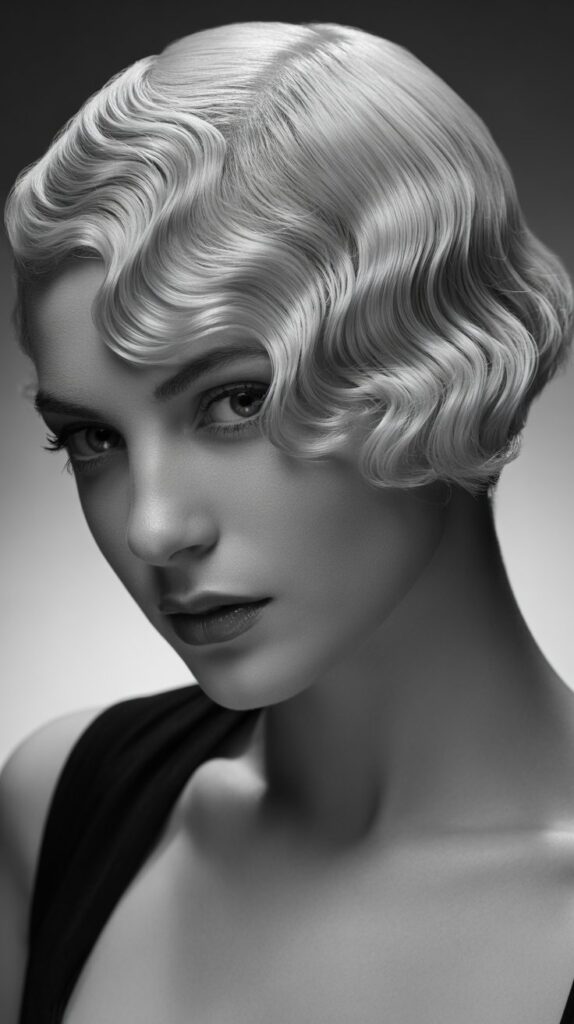
The wavy pixie with finger waves incorporates vintage styling techniques that create S-shaped wave patterns, delivering Old Hollywood glamour in a modern short-hair package. This sophisticated variation showcases thick hair’s ability to hold dramatic styling.
- Finger waves are created using setting lotion, combs, and fingers to mold wet hair into precise S-shaped curves that dry into sculptural, uniform waves.
- Thick hair maintains finger wave patterns exceptionally well because natural density provides structure that holds the molded shapes throughout the day.
- This technique creates red-carpet-worthy glamour perfect for formal events, weddings, vintage-themed occasions, or anytime you want maximum elegance and impact.
- Creating finger waves requires skill and patience—the wet-setting process takes 20-30 minutes, plus drying time using hood dryers or extended air-drying.
- The sculptural quality of finger waves photographs beautifully, making this styling choice ideal for special occasions where photography is important.
- Modern interpretations combine traditional finger wave technique with contemporary pixie cutting, creating fusion styles that honor vintage aesthetics while maintaining current relevance.
- This styling works best as an occasional special-event choice rather than daily wear, as the precision and time investment make it impractical for routine styling.
24. Wavy Pixie with Textured Crown
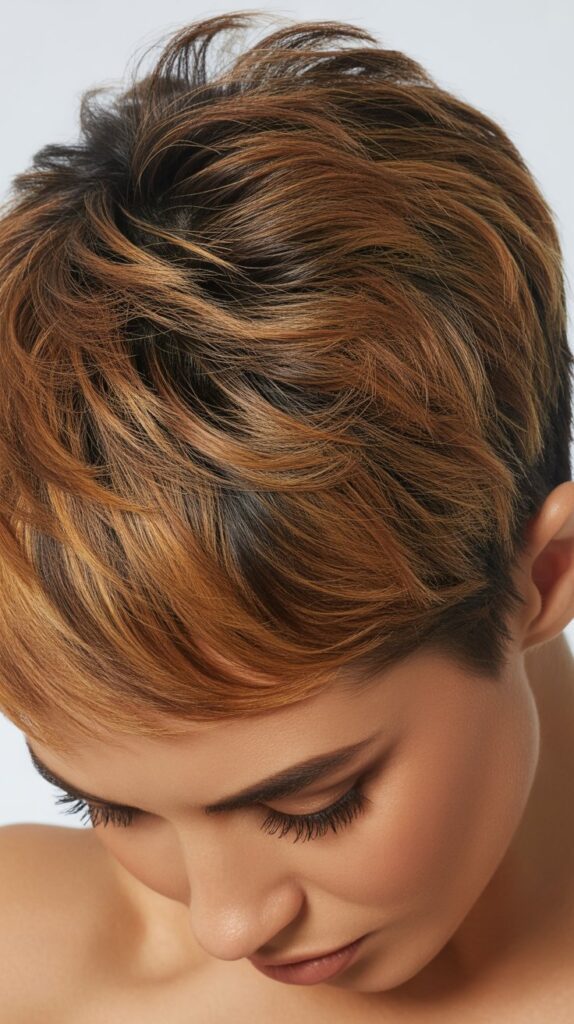
The wavy pixie with textured crown concentrates maximum volume and texture at the top of the head while keeping sides and back more controlled, creating focal point styling that draws eyes upward. This strategic variation flatters while managing thick hair’s natural body.
- The crown section receives enhanced texturizing through layering, product application, and styling techniques that create deliberate height and fullness at the highest point.
- Thick hair naturally wants to create volume at the crown, so this style works with rather than against your hair’s tendencies, requiring minimal effort to achieve impressive results.
- Strategic product placement—applying volumizing mousse or root lift spray specifically at the crown before styling—enhances natural lift without creating overall heaviness.
- The elevated crown creates vertical lines that elongate the face and add height, particularly flattering for round, square, or heart-shaped faces seeking lengthening effects.
- Styling involves focusing blow-drying or diffusing efforts on the crown area, lifting hair at the roots while directing airflow upward and backward.
- The textured, voluminous crown contrasts beautifully with sleeker, more controlled sides and back, preventing overwhelming or disproportionate silhouettes.
- This variation offers excellent versatility—enhance crown texture for dramatic occasions or reduce it for more subtle everyday styling.
25. Edgy Wavy Pixie with Multiple Lengths
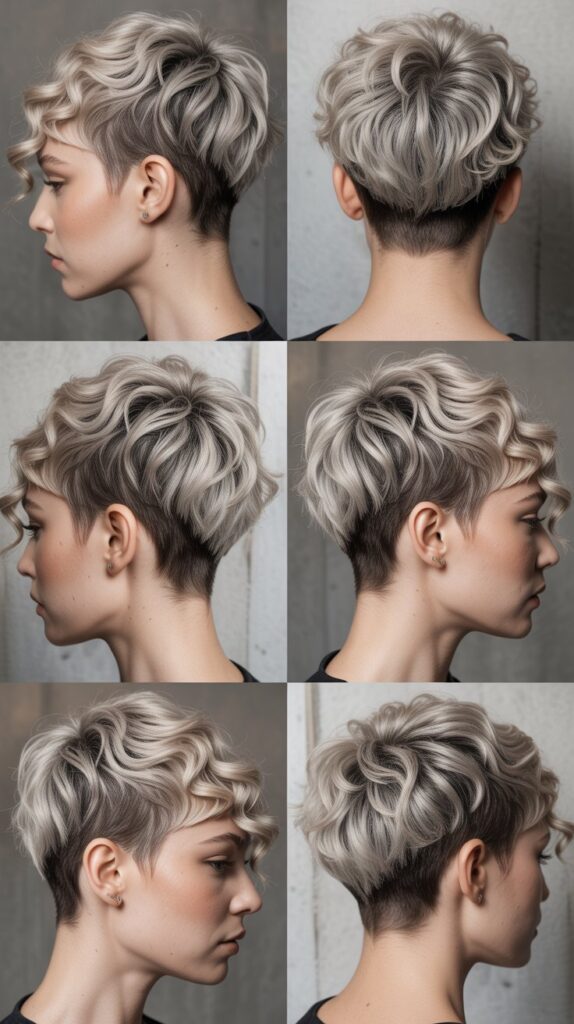
The edgy wavy pixie with multiple lengths incorporates intentionally varied sections throughout the cut, creating dimensional complexity that showcases thick hair’s versatility. This avant-garde variation delivers maximum visual interest through strategic length distribution.
- Multiple distinct length zones—typically including longer crown sections, medium-length sides, and shorter nape areas—create architectural interest impossible in uniform-length cuts.
- Each length zone can be styled differently, with longer sections showing enhanced waves while shorter sections remain sleeker or more closely cropped.
- Thick hair handles multiple length transitions beautifully because sufficient density in each zone maintains body and prevents sparse or thin appearance anywhere.
- The deliberately complex cutting creates styles that reveal new details and interesting angles with every head movement and viewing perspective.
- This variation suits creative professionals, artists, and individuals in fashion-forward industries where innovative, boundary-pushing aesthetics are celebrated.
- Styling flexibility means you can emphasize different length zones depending on your mood—feature the longer wavy sections or showcase the shorter edgy areas.
- Maintenance requires skilled stylists who understand the intentional design and can preserve the specific length relationships during trimming sessions every 6-8 weeks.
26. Wavy Pixie with Side-Swept Volume
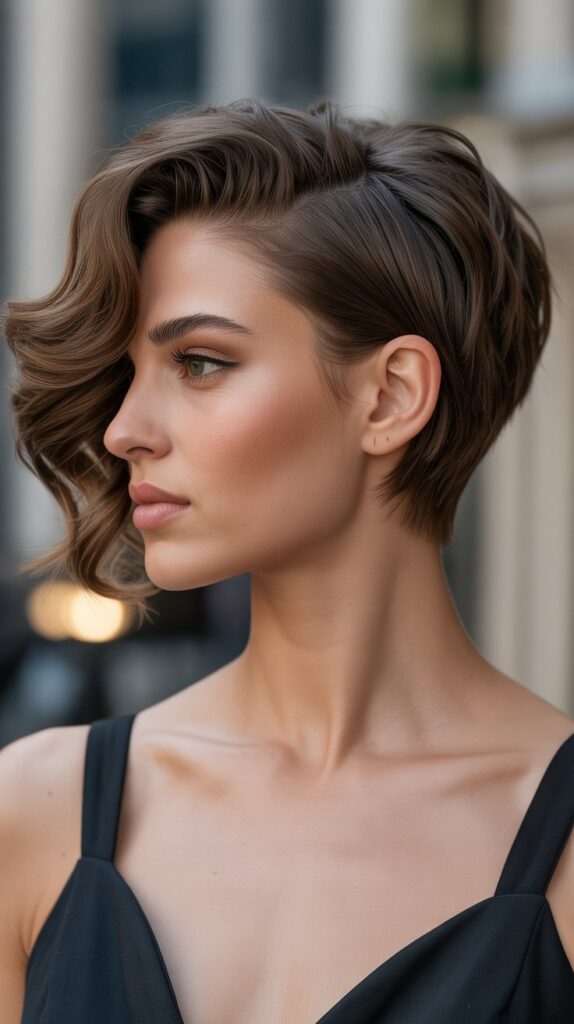
The wavy pixie with side-swept volume directs all the hair’s natural body toward one side, creating asymmetrical drama that flatters face shapes while showcasing thick hair’s gorgeous texture. This glamorous variation delivers red-carpet sophistication with romantic softness.
- The deep side part creates foundation for dramatic side-sweeping, with hair flowing across the forehead and temple toward the opposite side.
- Thick hair provides natural weight and body that maintains the side-swept shape without requiring excessive product or pinning that creates stiff, unnatural appearance.
- The volume concentrated on one side creates beautiful asymmetry that draws attention to eyes and cheekbones while adding width where flattering.
- Styling involves blow-drying with a round brush while directing all hair toward the heavy side, creating smooth flow from part to ends.
- This elegant styling particularly suits formal occasions, professional presentations, or evening events where polished sophistication is desired.
- The side-swept volume can be secured with discrete bobby pins behind the ear on the lighter side, ensuring all-day hold without visible hardware.
- Face shape considerations: this style particularly flatters oval, square, and rectangular faces, while round faces should ensure adequate height at the crown to balance horizontal volume.
27. Natural Wavy Pixie with Air-Dried Texture

The natural wavy pixie with air-dried texture celebrates your hair’s authentic patterns and texture, requiring minimal intervention while delivering effortlessly beautiful results. This low-maintenance variation is perfect for embracing thick hair’s natural characteristics.
- Air-drying eliminates heat damage and time investment while allowing hair’s natural wave pattern to emerge organically without manipulation.
- The cut itself is designed to work with natural texture—layers remove bulk and create shape that looks intentional even without styling intervention.
- Thick hair air-dries beautifully because natural density prevents limpness, maintaining body and volume throughout the drying process.
- Minimal product application—typically just leave-in conditioner or lightweight curl cream applied to damp hair—enhances natural waves without weighing them down.
- This approach prioritizes hair health, eliminating daily heat exposure that can cause damage, dryness, and color fading over time.
- The truly low-maintenance routine involves washing, applying product, scrunching gently, and allowing hair to dry naturally while you continue with your day.
- This variation suits those who value simplicity, natural beauty, environmental consciousness (no electricity usage), and authentic self-expression over heavily styled perfection.
Styling Tips for Wavy Pixie Cuts on Thick Hair
Achieving and maintaining gorgeous wavy pixie styles requires understanding specific techniques and products that work best with thick hair’s unique characteristics. These professional tips will help you maximize your cut’s potential.
- Product Selection: Choose lightweight formulas specifically designed for thick hair—heavy products weigh down waves while light mousses, sea salt sprays, and texturizing mists enhance without greasiness.
- Application Technique: Apply styling products to damp (not soaking wet) hair by scrunching upward from ends to roots, encouraging natural wave formation while distributing product evenly.
- Drying Methods: Air-drying preserves natural texture with zero damage, while diffusing on low heat speeds the process without disrupting wave patterns—avoid direct blow-drying which can cause frizz.
- Refresh Routines: Between wash days, revive waves using water-based refresh sprays, scrunching gently to reactivate products and reshape flattened sections without complete rewashing.
- Night Protection: Sleep on silk or satin pillowcases to reduce friction that causes frizz and wave disruption, or use a silk sleep cap for maximum protection.
- Tool Investment: Small-barrel curling wands (3/4 inch to 1 inch) enhance specific sections when desired, while flat irons can smooth problem areas without eliminating overall texture.
- Professional Maintenance: Schedule regular trims every 4-8 weeks depending on your specific cut’s requirements to maintain shape, remove damaged ends, and preserve the style’s integrity.
Maintenance Schedule for Wavy Pixie Cuts
Maintaining your wavy pixie at its best requires consistent professional care combined with proper home styling routines that preserve the cut’s shape and your hair’s health.
- Professional trim frequency varies by specific cut: ultra-short variations with shaved sections require maintenance every 2-3 weeks, while longer wavy pixie bobs can extend 8-10 weeks between appointments.
- Color maintenance depends on your chosen service: all-over permanent color needs root touch-ups every 4-6 weeks, highlights require refreshing every 8-12 weeks, and fashion colors need attention every 3-4 weeks.
- Deep conditioning treatments should occur weekly for heat-styled hair or every two weeks for air-dried styles, replenishing moisture that thick hair can lack despite appearing healthy.
- Clarifying shampoo usage once monthly removes product buildup that accumulates from styling products, restoring hair’s natural texture and allowing products to work effectively again.
- Professional texturizing services may be needed every 2-3 months if your thick hair becomes too dense, with stylists using specialized techniques to remove bulk without shortening length.
- Seasonal adjustments account for environmental changes: summer may require more frequent trims as hair grows faster, while winter focuses on moisture retention in dry indoor air.
- Home care consistency matters more than intensive occasional treatments—daily proper product use and gentle handling preserve cuts better than neglect followed by emergency repair attempts.
Face Shape Considerations
Understanding how different wavy pixie variations complement specific face shapes helps you choose the most flattering version for your unique features and proportions.
- Oval Faces: The most versatile face shape can wear virtually any wavy pixie variation, from ultra-short crops to longer pixie bobs, with minimal concerns about proportion.
- Round Faces: Benefit from pixies with height at the crown and longer front sections that create vertical lines, avoiding styles that add width at the sides or temples.
- Square Faces: Softened by wavy texture and longer front pieces that curve around the jawline, while avoiding blunt lines that emphasize angular features.
- Heart-Shaped Faces: Flattered by textured fringe and volume at the jaw level that balances wider foreheads, while tapered sides prevent emphasizing narrow chins.
- Long/Rectangular Faces: Enhanced by side-swept styles, textured fringe, and horizontal volume that creates width, while avoiding excessive height at the crown that elongates further.
- Diamond Faces: Complemented by chin-length front sections and fullness at the crown that balances narrow foreheads and chins while softening prominent cheekbones.
- Professional consultation remains essential—experienced stylists assess your specific features beyond general face shape categories, considering profile, neck length, and personal style preferences.
Color Ideas for Wavy Pixie Cuts
Strategic color choices enhance wavy pixie cuts by adding dimension, highlighting texture, and creating depth that makes thick hair appear even more dynamic and interesting.
- Balayage Highlighting: Hand-painted highlights that concentrate lightness around the face and crown create natural-looking dimension that enhances wave patterns beautifully.
- Ombré Effects: Gradual color transitions from darker roots to lighter ends work surprisingly well in pixie cuts, creating the illusion of even more texture and movement.
- Peek-a-Boo Panels: Hidden vibrant colors underneath top layers (blues, purples, pinks) provide creative expression with professional versatility, as they can be concealed or revealed by styling.
- Dimensional Brunettes: Multiple shades of brown throughout thick hair prevent flatness, with lighter caramel or honey tones highlighting waves and creating richness.
- Platinum and Silver Tones: Cool-toned light colors create striking contrast with wavy texture, though they require significant maintenance and professional color expertise to maintain.
- Rich Jewel Tones: Deep reds, burgundies, and aubergines add luxurious depth while enhancing wavy texture through light reflection and color variation.
- Natural Enhancement: Single-process color that’s 1-2 shades different from natural color can refresh appearance while adding shine and dimension that highlights thick hair’s texture.
Transitioning to a Wavy Pixie
Making the leap from longer hair to a wavy pixie requires both practical preparation and emotional readiness for a dramatic transformation that will significantly change your appearance and daily routines.
- Research thoroughly by collecting inspiration photos from multiple angles (front, sides, back) showing pixie cuts on people with similar hair texture and face shapes to yours.
- Choose an experienced stylist specializing in short hair rather than generalists—check portfolios, read reviews, and don’t hesitate to schedule consultations before committing to the cut.
- Consider gradual transitions if you’re uncertain: move from long hair to a bob first, then to a longer pixie bob, allowing adjustment periods before reaching your final short length.
- Discuss styling reality honestly with your stylist—if you won’t heat-style daily, choose cuts designed to air-dry beautifully rather than styles requiring significant maintenance.
- Prepare for emotional responses from yourself and others—dramatic hair changes can feel liberating, shocking, or regretful initially, with true feelings often emerging after several days.
- Understand the commitment involves regular maintenance: pixie cuts require more frequent professional trims than longer styles to maintain their shape and intentional appearance.
- Accept that growing out will take patience if you eventually want longer hair again—pixies create awkward intermediate lengths that require strategic cutting and styling during the transition.
Common Mistakes to Avoid
Understanding frequent errors people make with wavy pixie cuts helps you sidestep problems and maintain gorgeous results from your thick hair transformation.
- Over-washing strips natural oils that thick hair needs for moisture and wave definition—limit shampooing to 2-3 times weekly unless hair becomes genuinely dirty or sweaty.
- Using products designed for fine hair won’t provide adequate hold or texture for thick hair, leading to flat, shapeless results that don’t showcase the cut’s intended design.
- Skipping regular trims to save money ultimately costs more as overgrown pixies lose their shape entirely, requiring more extensive cutting to restore rather than simple maintenance trimming.
- Heat-styling without protection causes cumulative damage that creates frizz and disrupts wave patterns, making hair progressively harder to style attractively over time.
- Choosing cuts based solely on celebrity photos without considering your hair’s specific texture, density, and growth patterns often leads to disappointment when results differ from expectations.
- Neglecting the back and sides during home styling creates polished fronts with neglected rears—use mirrors to check all angles and ensure consistent styling throughout.
- Attempting complex color services at home on short hair often results in uneven application and difficulty reaching all areas, making professional color services worthwhile investments.
Styling Wavy Pixies for Different Occasions
Versatility makes wavy pixies practical for diverse situations, with simple adjustments transforming the same cut from casual to formal depending on your styling approach.
- Casual Everyday Wear: Air-dried texture with sea salt spray creates effortless, low-maintenance style perfect for errands, casual workplaces, and relaxed social situations.
- Professional Office Settings: Smooth sides with controlled wave definition on top using light mousse and diffusing delivers polished sophistication appropriate for business environments.
- Formal Evening Events: Enhanced waves with shine serum, side-swept styling, and possible accessories like jeweled clips or headbands create red-carpet-worthy glamour.
- Active Workouts: Minimal product application with hair pushed back using headbands or secured with small clips keeps style off your face during exercise while preventing sweat damage.
- Beach and Pool Days: Embrace the inevitable texture that water creates by pre-treating with leave-in conditioner, then allowing natural drying for perfectly imperfect beachy waves.
- Date Nights: Slightly more defined waves using small-barrel curling iron on select sections, combined with subtle volume at the crown, creates romantic softness while maintaining pixie edge.
- Video Calls and Photography: Extra attention to crown volume and face-framing pieces ensures camera-ready appearance, as cameras often flatten texture that looks great in person.
Seasonal Adaptations
Adjusting your wavy pixie care and styling routine according to seasonal changes helps maintain gorgeous results year-round despite varying environmental conditions.
- Summer Strategies: Increased humidity requires frizz-control products and styles that embrace texture rather than fighting natural volume, while UV protection prevents sun damage and color fading.
- Winter Adjustments: Dry indoor air necessitates increased moisture through leave-in conditioners and weekly deep treatments, while static control products prevent flyaways from heating systems.
- Spring Renewal: Seasonal shedding may thin thick hair temporarily, making this ideal timing for growth-promoting treatments and potentially adjusting cuts to accommodate changing density.
- Fall Preparation: Transition from summer sun exposure requires repairing any damage through intensive conditioning treatments and possibly trimming away compromised ends before winter’s harshness.
- Humidity Management: High-moisture environments require products with humidity-blocking properties and styles that work with rather than against the expanded, voluminous texture humidity creates.
- Cold Weather Protection: Hats and scarves can flatten pixie cuts, so choose smooth satin linings and refresh styling upon removal with dry texturizing spray and finger-scrunching.
- Vacation Considerations: Travel to different climates may require bringing adaptive products—both humidity-control and moisture-adding options ensure you can respond to unexpected environmental conditions.
Cost Considerations
Understanding the financial investment required for maintaining a wavy pixie cut helps you budget appropriately and avoid surprises that might compromise your hair’s appearance.
- Initial Cut Investment: Quality pixie cuts from experienced specialists typically cost $50-150 depending on location, salon prestige, and stylist experience level—worth the investment for proper foundation.
- Regular Maintenance Trimming: Plan for professional cuts every 4-8 weeks at $40-80 per visit, creating annual maintenance costs of $240-960 depending on your specific cut’s requirements.
- Color Services Add Significantly: Full highlights cost $100-250 every 8-12 weeks, all-over color runs $60-120 every 4-6 weeks, and fashion colors require $80-150 every 3-4 weeks.
- At-Home Product Expenses: Quality styling products cost $15-35 each and last 2-4 months with pixie-length hair, creating annual product budgets of approximately $200-400 for complete routines.
- Tools and Accessories: One-time investments in diffusers ($25-50), small-barrel curling wands ($30-80), and quality brushes ($15-40) support effective home styling.
- Money-Saving Strategies: Less frequent washing reduces product usage, air-drying eliminates electricity costs, and maintaining hair health reduces need for expensive repair treatments.
- Long-Term Value: While pixies require frequent professional maintenance, the reduced product usage compared to long hair and time saved on daily styling can offset costs for busy individuals.
Confidence and Lifestyle Impact
Cutting your hair into a wavy pixie creates changes that extend far beyond appearance, often influencing self-perception, daily routines, and how others respond to you.
- Liberating Freedom: Many people report feeling lighter physically and emotionally after cutting significant length, experiencing newfound confidence and adventurousness in other life areas.
- Time Reclamation: Reducing daily hair routine from 30-60 minutes to 5-15 minutes gives back substantial time over weeks and months for other priorities and interests.
- Identity Evolution: Dramatic hair changes often mark transitional life periods—new jobs, relationship changes, personal growth—serving as external manifestations of internal transformations.
- Attention and Comments: Short hair on women still attracts comments and questions from strangers, requiring emotional preparation for increased attention (both positive and negative).
- Professionalism Perceptions: While attitudes evolve, some conservative industries still view very short women’s hair as less professional, making workplace culture consideration important before cutting.
- Maintenance Commitment Reality: The freedom of short hair comes with responsibility for regular professional maintenance—missed appointments create visible neglect faster than with long hair.
- Authentic Self-Expression: For many, short hair feels more aligned with authentic identity than long hair maintained due to social expectations, creating genuine comfort and satisfaction.
Conclusion
The journey through these 27 Gorgeous Wavy Pixie Hairstyles for Thick Hair reveals the incredible versatility and beauty that short cuts offer when specifically designed for thick, textured hair.
From classic textured styles to bold asymmetrical designs, from professional graduated necklines to playful peek-a-boo colors, the wavy pixie universe contains countless variations that accommodate different face shapes, personal styles, and lifestyle needs.
Thick hair’s natural body and volume transform from potential challenges into stunning assets when shaped by skilled stylists who understand how to remove bulk strategically while showcasing gorgeous wave patterns.
Whether you choose dramatic shaved sides, romantic finger waves, or effortlessly tousled air-dried texture, your wavy pixie can express your unique personality while simplifying your daily routine. The confidence boost that comes from a perfectly executed short cut often extends beyond appearance, influencing how you approach challenges and present yourself to the world.
By understanding proper maintenance requirements, styling techniques, and product selections outlined throughout this guide, you’re equipped to make informed decisions about your hair transformation and maintain stunning results long-term.
The liberating experience of a wavy pixie awaits—embrace the chop, celebrate your thick hair’s texture, and discover the gorgeous possibilities that 27 Gorgeous Wavy Pixie Hairstyles for Thick Hair can bring to your life.
